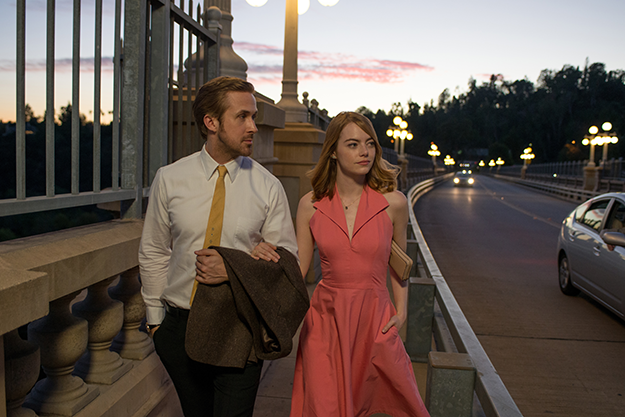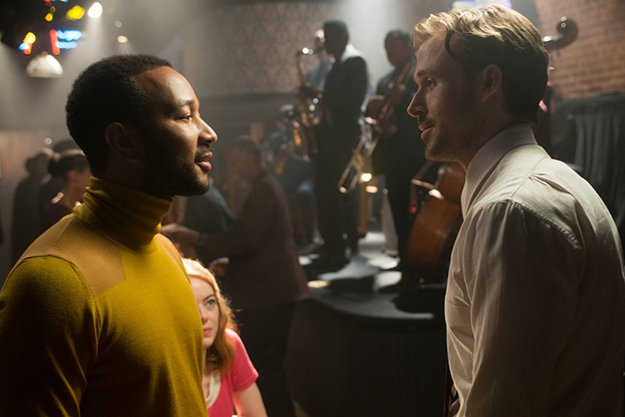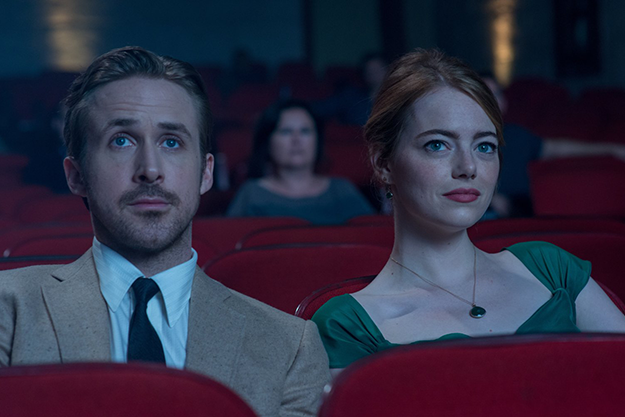Everything about La La Land balances the retro and the cutting-edge, including the title phrase, which has a definite 1980s ring to it but may be coming back strong, just like denim jackets. Damien Chazelle’s musical about two Los Angeles dreamers, a jazz pianist named Sebastian (Ryan Gosling) and a struggling actor named Mia (Emma Stone), is a slender, charming anomaly—a nostalgia trip geared for immediacy. Chazelle’s script combines a girl-meets-boy story with a glad-rags-to-riches tale, then filters it through the films of Astaire and Rogers, Gene Kelly, Stanley Donen, Vincente Minnelli, and, especially, Jacques Demy. For the 31-year-old Chazelle, who broke through with the mechanical and overheated Whiplash (2013), La La Land is a big leap forward. His filmmaking exuberance and the energy and sweetness of his two stars give this thin soup considerable tang. The story is comprised of elements so dusty they could have been stored in a fall-out shelter. Seb and Mia meet not-so-cute on a backed-up freeway—he angrily honks his horn, she gives him the finger—yet she falls for his music when she stumbles on him tickling the ivories at a restaurant. We’ve already learned by then that Mia works as a barista on the Warner Bros. lot, rooms with three other aspiring performers, and has run the casting gauntlet on one fruitless, soul-shriveling audition after another. Now we go back in time to learn why Seb is in such a foul mood. There’s no market for what he wants to do, which is to play his idea of pure jazz, which encompasses Louis Armstrong and Charlie Parker and Miles Davis, though his own pet compositions sound more like elegant movie music or Broadway reveries. His boss at the restaurant (J.K. Simmons) wants him to tinkle holiday tunes. He dreams of opening a jazz club on a historic site that he says is being desecrated as a “samba and tapas” joint. (Seb expresses disbelief at the concept, but a quick Google search suggests that “samba and tapas” is an actual thing.) Seb scowls at Mia during their first three meetings, but there’s no doubt that his serrated edges surround an honorable soul and that her big heart and innocence will pierce his defenses. The film’s wispiness, in an odd way, adds a modicum of suspense. After the film gambols through its romantic beats, we wonder, “Where will they go from here?” The movie’s splashy freeway opening features dozens of dancers of every racial and ethnic type filling out an ultra-wide CinemaScope screen as they cavort in between and on the hoods of cars while singing an L.A. anthem: “Another Sunny Day.” It’s infectious and amusing, but after that and a girls-night-out group song called “Someone in the Crowd,” I dreaded facing one tricked-out chorus number after another—neat packages of energy tied up with gimmicky bows, like a water-soaked rotating shot from the point of view of fun-lovers who leap into a swimming pool at a Hollywood Hills party. Linus Sandgren’s virtuoso moving camera appears to have everything except a set of brakes, and Chazelle shoots the works with visual effects that make us feel we’re fizzing inside a champagne glass.
Still, from the start, Stone packs wit and passion into her nightmare try-out scenes, while Gosling is a master of slow-burn frustration. Chazelle’s canniest move was casting these two people, not only because of their acting gifts, but also because they were virtually “born in a trunk.” Gosling began his performing life as a Mouseketeer on the Disney Channel’s Mickey Mouse Club. Stone started acting on stage to overcome childhood panic attacks, and as a teenager moved to L.A. with her mom to act on TV and in films. Gosling, who has alternated strings of artistic and/or commercial hits with misfires, and has taken a couple of time-outs from acting, imbues Seb with a persuasive ebb and flow of cockiness and ruefulness. Stone, who once said she hit “rock-bottom” when the producers of TV’s Heroes turned her down, explores a sunny character’s capacity for humiliation and despair. When Seb and Mia’s opposition turns to attraction, they face the music and dance—and they’re marvelous together. At that point, Mandy Moore, the choreographer, who comes from Dancing with the Stars, drops the rhythmic acrobatics and takes up the rough magic of two game performers expressing the push-pull of emotions via movements that go artfully in and out of synch. Chazelle and Sandgren frame their jumps, taps and sways so we see them from head to toe, registering every click of heel on pavement, each skyward-swooping gesture, as if they’re giving outward form to the swelling of their hearts. Both Gosling and Stone are comfortable enough to look as if they’re just playing around while maintaining a ballroom posture or a balletic line. As singers, they’re even better. Early on we learn that Gosling has an apt voice for balladry, soft and insinuating, like Chet Baker’s (Gosling belongs to an indie-rock duo, Dead Man’s Bones), while Stone has a breathy quality but is also firm and unwavering (she recently played Sally Bowles in Cabaret on Broadway). Whether vocalizing or whirling or both, they convey sentiment, lightness, and warmth more directly than most practiced musical-comedy stars. They provide us with a pleasure comparable to hearing Diane Keaton sing “You’d Be So Nice to Come Home To” in Woody Allen’s Radio Days, and they have the benefit of moving expressively, too, rather than standing at a microphone. Considering that the songwriters had to create something out of nothing—a complete score from Chazelle’s Platonic ideal of show tunes—composer Jason Hurwitz and lyricists Benj Pasek and Justin Paul inject surprising oomph into the lovers’ duets and a feathery lyricism into their solos. (Pasek and Paul have just won raves for the Broadway production of Dear Evan Hansen.) You want Mia and Seb to connect partly because you want to see Stone and Gosling perform together. And when they’re apart, they’ve still got game. In her designated showstopper, Stone manages to deliver a salute to what The Muppet Movie calls “the lovers, the dreamers, and me,” with a conviction that carries us along, even if the number itself does resemble Kermit the Frog’s “Rainbow Connection” reshaped as a torch song.
Chazelle dresses Mia and her friends in colors straight out of a primary crayon box (one of several nods to Demy’s Young Girls of Rochefort) and places them in a dreamscape that’s tantalizing, bracing, yet naggingly derivative of everything from Swing Time to Cover Girl. La La Land begs to be dubbed “a love letter to L.A.,” but it’s a tourist’s love letter, complete with the usual jokes about traffic and the dominance of the movie industry, and shrewdly put together from picture-postcard locations like the Griffith Park Observatory and the Watts Towers and Angel’s Flight as well as cultural landmarks like the Rialto Theatre in South Pasadena. Chazelle wants us to see that Seb and Mia are just passing through one apartment or another on the way to artistic fulfillment. Their supporting relationships—whether Mia’s with her interchangeable roommates and nondescript parents, or Seb’s with his loving sister (Rosemarie DeWitt) and affable bandleader (John Legend)—might as well have been written in invisible ink. Mia falls in love with Seb’s talent, and Seb becomes Mia’s biggest booster, advising her to write a role for herself when the breaks don’t come her way. (She creates a one-woman show.) La La Land is said to be an “adult” fantasy because each of them eventually experiences the conflict between love and art. Chazelle proves that he can write a blistering domestic argument or two, but his vision isn’t rich enough to support the magical sight of the couple soaring to the top of Griffith Park Planetarium and dancing in the stars as well as the couple bickering over dinner about Seb being trapped in a regular job that takes him on the road playing music he doesn’t love. The movie’s two sides don’t mesh. Its resolution is too deliberately laid out to be authentically poignant. At the end it’s still an adolescent fantasy, just a bittersweet one—a wish fulfillment with a slightly guilty conscience. Chazelle has said that his biggest influence by far is Demy’s The Umbrellas of Cherbourg, and the film’s “five years later” epilogue is an attempt to meld the devastating Christmastime postscript of Cherbourg with the kind of kaleidoscopic alternate-universe dance number that climaxed Minnelli and Kelly’s An American in Paris. It’s dazzling, all right, but there’s no zing or heartbreak to it. Demy’s song-and-dance universe was the unlikely, inspired product of his youth in Nantes, a commercial port town in Western France where his family ran an auto-repair shop. Chazelle is all about paper moons and cardboard seas and canvas skies.
Demy, unlike Chazelle, uses music and stylization to sustain an atmosphere of heightened feeling whether his lovers are together or torn apart. His romance about first love and adult love is the unusual movie that fully honors both. Everyone probably remembers something about Umbrellas: that the dialogue is sung; or that its songs became international hits (notably the one under the title “I Will Wait for You”); or that Catherine Deneuve and Nino Castelnuovo, as the salesgirl in her widowed mother’s umbrella shop and the garage mechanic who lives with his aged aunt, are a surpassingly graceful couple. But the mother (Anne Vernon) is also a wonderful character, worldly wise yet not sour; and after Castelnuovo is called up for service in Algeria, the globetrotting Parisian who courts Deneuve turns out to be a hell of a guy, just as the gal Castelnuovo catches on the rebound becomes his rock of sanity. Chazelle’s conception doesn’t have that depth or follow-through. (And Demy was only two years older than Chazelle is now when he made his masterpiece.) Chazelle possesses an undeniable gift for transport, and that is rare. But his yen for myth-making is too flimsy, because it isn’t rooted in anything except his love for movie musicals. He’s a talented director, but it would do him a disservice to laud him, prematurely, as a giant. He’s the opposite of Antaeus—he loses his potency when he comes to earth. Michael Sragow is a contributing editor to Film Comment and writes its Deep Focus column. He is a member of the National Society of Film Critics and the Los Angeles Film Critics Association. He also curates “The Moviegoer” at the Library of America website.



